Many photographers are excited about the new JPEG-XL compatibility in ProRAW mode of the iPhone 16 Pro series. This curiosity reveals the significance of the new format for pros as well as for casual photographers. JPEG-XL guarantees more editing options, reduced file sizes, and superior photo quality. But specifically how does this influence iPhone photography?
In this article, we provide the key benefits of JPEG-XL. Also, what this means for people who seek the best out of their iPhone 16 cameras.
Fix JPEG-XL Image Format Effortlessly

In this article
Part 1: What is JPEG-XL?
Designed to improve both quality and storage economy in photography, JPEG-XL is a trendy format. Unlike earlier formats, JPEG-XL satisfies the needs of today's users. It offers a versatile solution for both casual and professional photographers.
This format solves the limits of standard picture types by providing high-quality graphics alongside reduced file sizes. You can manage your photo libraries more effectively which sometimes have limited storage capacity. JPEG-XL ensures that photographers may shoot and save great photographs without losing space.
Advantages of Using JPEG-XL
- Highly Efficient Compression
JPEG-XL excels in reducing file sizes compared to earlier formats like JPEG. This efficiency allows you to save a greater number of photographs on your smartphone while preserving high visual quality.
- Dual Compression Modes
The format supports both lossy and lossless compression methods. You can pick lossy compression for everyday images, where smaller file sizes are a priority. You can also utilize lossless compression to retain all image details for major shots.
- Wider Color Range
JPEG-XL enables a broader pallet of colors and sharper gradients. This attribute leads to enhanced image quality. It makes it excellent for recording scenes with varied color changes.
- Future Compatibility
JPEG-XL is aimed to replace numerous previous formats, improving the process of handling photos. This forward-thinking strategy ensures that photographers may rely on one adaptable format for varied needs.
- Enhanced Metadata Support
The format provides for comprehensive metadata storage. It offers important information like shooting settings and situations. This capability helps photographers organize and locate their photographs more efficiently, boosting their workflow.
How JPEG-XL Enhances iPhone Photography?
By adding JPEG-XL, owners of the iPhone 16 Pro and Pro Max can access advanced photography tools through ProRAW mode. This breakthrough format is designed to optimize image storage without compromising on quality.
Photographers can enjoy many special benefits:
- Improved Detail Preservation: JPEG-XL captures great details in complicated photos, such as landscapes. It results in crisper and more vivid photographs.
- Flexibility in Editing: The format maintains more information than standard JPEGs. It allows a broader leeway for editing tweaks. Users can alter exposure, contrast, and color balance while keeping the image quality intact.
- Quick Sharing Options: The reduced file sizes associated with JPEG-XL enable faster uploads and simpler sharing. It is vital for professional photographers who need to deliver photographs swiftly. This convenience facilitates productive engagement with clients and team members.
Part 2: How to Choose JPEG-XL in iPhone 16 Pro?
Using JPEG-XL on your iPhone 16 Pro is easy, but you need to enable it in the right settings. Follow these steps to make sure your camera saves photos in this new format:
Step 1: Go to your iPhone Settings. Find Camera and select Formats.
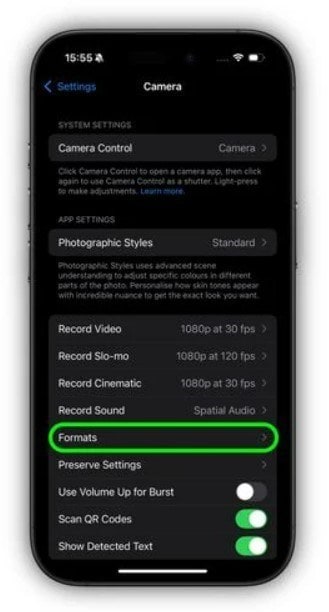
Step 2: Click Pro Default.
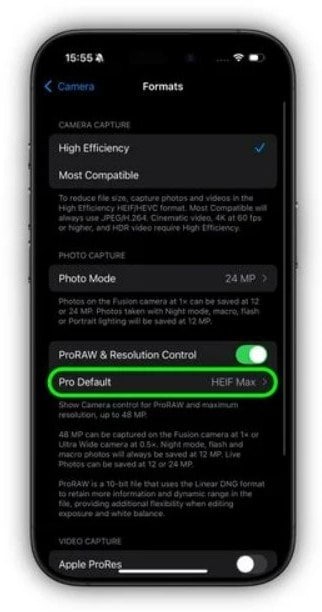
Step 3: Choose ProRAW Max (up to 48 MP) and select between JPEG Lossless (Most Compatible), JPEG-XL Lossless, and JPEG-XL Lossy.
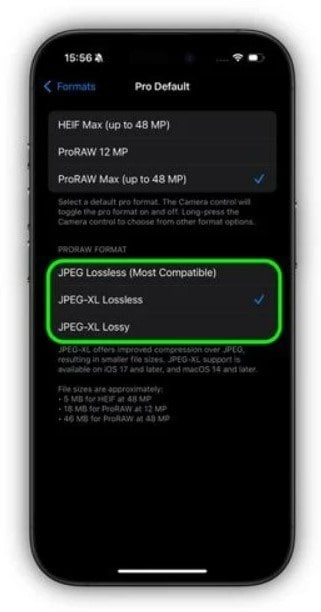
Enable ProRAW: Turn on the “ProRAW” option.
Select JPEG-XL: Under ProRAW options, choose JPEG-XL as the format.
Once enabled, your photos taken in ProRAW mode will automatically be saved in JPEG-XL. You can switch back to other formats anytime by returning to the same settings.
This option gives you more control over photo quality and file size, making it ideal for both casual and professional use.
Part 3: JPEG-XL VS JPEG
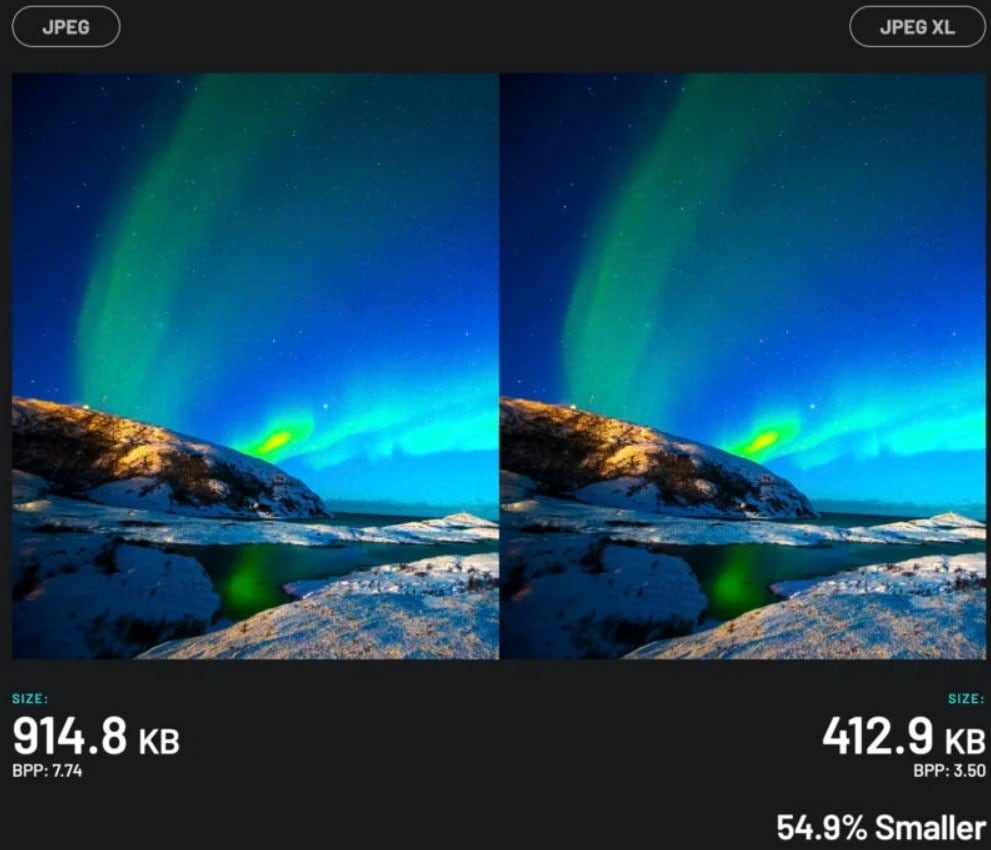
JPEG has been the default image format for years, but JPEG-XL offers a modern alternative with more advanced features. Understanding the differences between these two types might help you decide which one best matches your needs.
Comparison of Features: JPEG vs. JPEG-XL
| Feature | JPEG | JPEG-XL |
| Compression Options | Only lossy | Lossy and lossless |
| Image Quality | Prone to artifacts with compression | Maintains sharpness and fine detail |
| File Size Efficiency | Good, but can be limited | Better at reducing size with higher quality |
| Editing Capabilities | Limited once saved | Retains more data for re-editing |
| Color Support | Narrower range | Supports more vibrant colors and finer gradients |
| Adoption | Widely used | Emerging, with increasing support |
| Licensing | May require fees | Free to use (royalty-free) |
- JPEG: It is still helpful for web images and casual photography. But, JPEG fails to preserve quality when compressed frequently or substantially modified.

- JPEG-XL: On the iPhone 16, JPEG-XL makes a notable impact, especially in ProRAW photographs. It eliminates artifacts and preserves minor visual features, even after compression. This makes it suitable for both quick sharing and professional editing.

Part 4: The Ultimate Solution for Damaged JPEG-XL Photos
JPEG-XL is becoming an essential format for photographers since it provides high-quality photographs with advanced compression. For users of the iPhone 16 Pro and Pro Max, capturing ProRAW images in JPEG-XL ensures a balance between quality and storage space.
However, like any digital asset, these photographs can sometimes become corrupted due to software problems, failed transfers, or storage issues. Damaged JPEG-XL images may prohibit you from accessing precious memories or professional photographs. This is why having a reputable repair option is important.
Repairit Photo Repair is a powerful program designed to fix corrupted image files, including formats like ProRes RAW and now perhaps JPEG-XL. It helps you restore your files and ensure the photographs are accessible and editable again. With powerful algorithms, Repairit can repair complicated errors such as missing data, pixelation, and distorted images.
Key characteristics of Repairit Photo Repair:
- Supports multiple picture formats.
- Restores many photographs at once.
- Saves time when working with big files.
- Provides a preview mode to review corrected photos before saving.
- This software is suitable for both personal and professional images.
- It is ideal for casual users and photographers.
Here’s how to repair damaged JPEG-XL photos using Repairit Photo Repair:
Step 1. Launch Repairit on your desktop. Open the software and navigate to More Types Repair. Then, select Photo Repair.
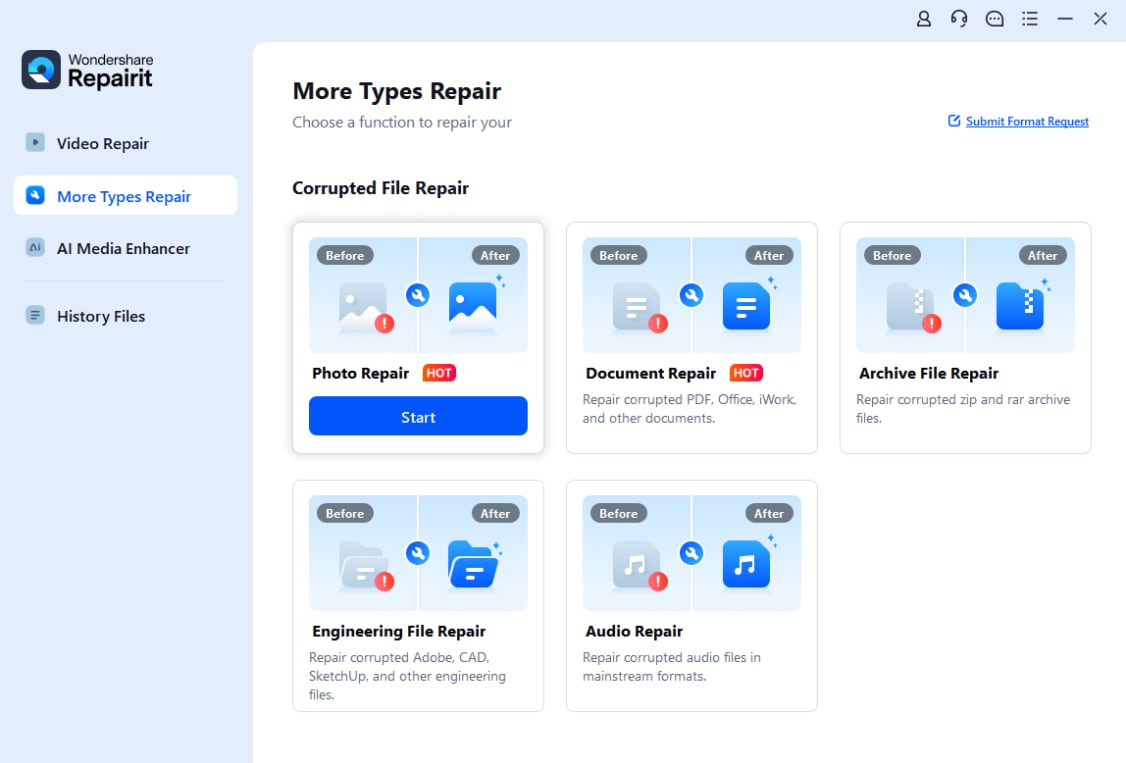
Step 2. Click +Add and choose the JPEG-XL you want to repair.

Step 3. Click Repair to begin.
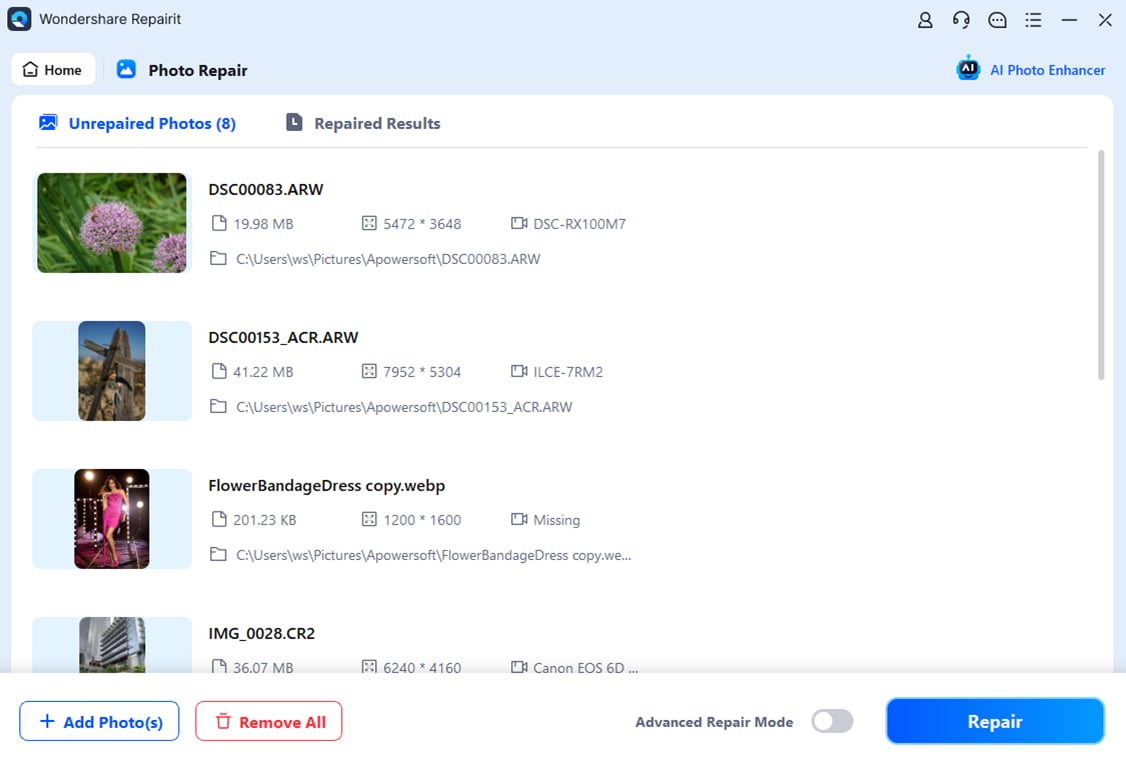
Step 4. Preview your JPEG-XL once done, and click Save to export the repaired photo on your target path.
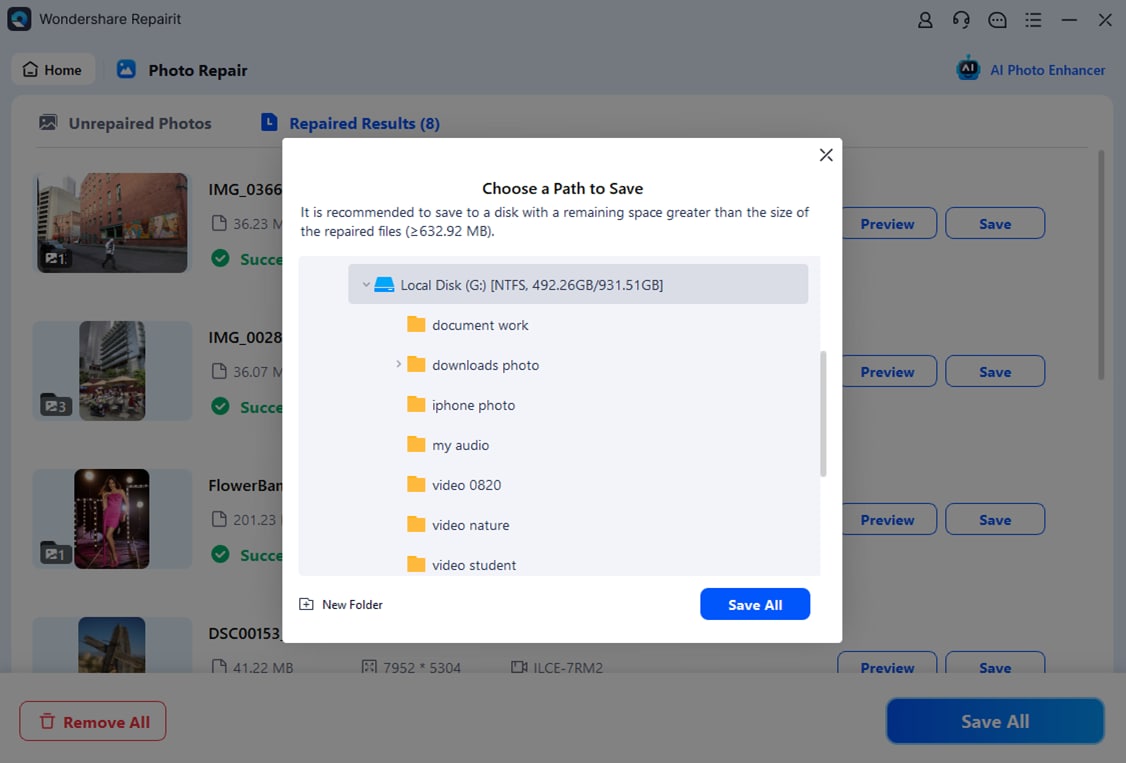
Fix Damaged JPEG-XL Photos

Conclusion
The introduction of JPEG-XL on the iPhone 16 Pro and Pro Max is a big step forward in iPhone photography. This new format offers you the best of both worlds smaller files with better quality. The dual support for lossy and lossless compression ensures flexibility. It helps photographers to combine storage needs with image fidelity.
As more devices begin to accept JPEG-XL, we might expect it to become the new standard for images. It replaces earlier formats like JPEG. With the ProRAW JPEG-XL function, Apple offers the iPhone 16 series as a powerful tool for photography enthusiasts. It enables you to capture great photos without worrying about file size or quality loss.
FAQ
-
Can older iPhones open JPEG-XL photos?
Older iPhones may not have built-in support for JPEG-XL, especially phones running previous iOS versions. Using third-party tools that support the format, including image viewers or editors, can help you open these files. -
Do I need to enable JPEG-XL on my iPhone 16?
Yes, you have to turn on JPEG-XL in the ProRAW options manually. Once activated, the camera app will save RAW photographs in JPEG-XL format. However, you can switch back to other formats anytime if needed. This versatility enables you to decide whether to snap photographs with better resolution and lesser file sizes.It’s essential to realize that JPEG-XL is only utilized for ProRAW photos, thus typical photos produced in automatic mode will continue using formats like JPEG or HEIF.
-
Can I share JPEG-XL images with other devices?
When sharing JPEG-XL images, it's good to check if the other person’s device can open the format. If not, you might use sharing programs like WhatsApp or Facebook Messenger, which may convert the file automatically. Keep in mind that converting JPEG-XL to a simpler format, like JPEG, may result in some quality loss. So, it's recommended to use the original file when possible if the receiver has the proper tools to open it.


 ChatGPT
ChatGPT
 Perplexity
Perplexity
 Google AI Mode
Google AI Mode
 Grok
Grok

